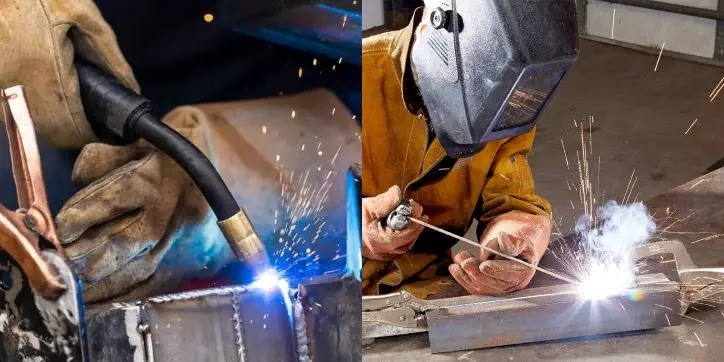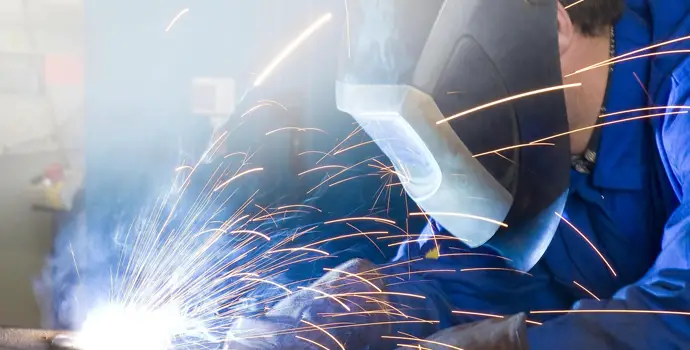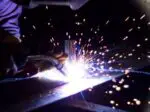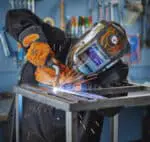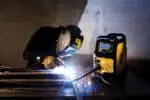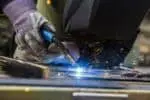MIG and stick welding are two of the most widely used arc welding methods. And, while they have certain similarities, one can give significantly superior outcomes than the other in specific applications.
Each of these methods of welding has advantages and disadvantages that make them suited for different purposes.
Although both MIG and stick welding may create a high-quality weld, their setups, advantages, disadvantages, and applications are significantly different.
Both MIG and stick welders face distinct safety problems. Stick welders may burn to a high temperature and become quite hot. When the arc makes contact with the metal, these welders produce spatter, which can cause burns if you are not wearing a helmet and other protective equipment.
Although, MIG welders aren’t completely safe either. It produces less spatter than a stick welder, but still may get rather hot at higher temperature settings. The shielding gas must also be kept under control.
In general, MIG welding is the easiest type of welding to learn and the easiest torch to use. While stick welding may also be learned quickly, it is more difficult to master. Therefore, MIG welding is comparatively safer than stick welding.
The potential safety risks in stick welding
Any welding operation must take safety into account. Here are a few hazards:
1.) Electric shock
Electric shock is one of the most significant and immediate hazards that a welder faces. Electric shock can cause serious damage or death, either from the shock itself or from a fall triggered by the shock’s reaction.
Electric shock happens when welders come into contact with two metal items that have a voltage between them, therefore entering the electrical circuit.
2.) Gases and fumes
Excessive exposure to welding fumes and gases can result in serious health issues such as respiratory infections, cancer, and impaired speech and mobility.
By following safety procedures and wearing appropriate PPEs, you may limit your exposure to vapors and gases.
3.) Explosions and fires
The most common cause of a fire is flammable objects in the workplace. This may be avoided by keeping the work area clean before beginning to weld and following the other safety precautions.
In the case of a fire, it is also critical to know where the fire alarms, emergency exits, and fire extinguishers are located.
4.) Injuries caused by inadequate PPE
Personal protection equipment serves to keep welding workers safe from injuries such as burns (the most frequent welding accident) and arc ray exposure. The proper PPE provides for freedom of movement while also protecting against welding dangers.
Leather and flame-resistant treated cotton clothes are preferred in welding situations due to their durability and fire resistance. This is due to the fact that synthetic materials, such as polyester or rayon, may melt when subjected to high temperatures.
Factors of comparison- MIG and stick welding
1.) Welding skill
Stick welds are less visually attractive than MIG welds. To accomplish deep penetration on thicker metals with MIG, the current must be set extremely high.
You must also ensure that the surface is absolutely free of rust and paint, otherwise the weld penetration will be severely hampered.
Stick welding may be untidy since it produces a lot of spatter and slag. As a result, it has to be cleaned often in between welds. On the plus side, impurities like corrosion, dirt, or paint have no effect on the depth of penetration in stick welding.
2.) Metals in use
One of the primary advantages of MIG welding is that it allows you to deal with a wide range of metals of varying thicknesses. This procedure should not be used to fuse heavy metals since it can severely harm your MIG welder.
It is most effective on thin metals such as copper, brass, magnesium, carbon steel, mild steel, stainless steel, and aluminum. It is effective on metals as thin as 26 gauge. Simply ensure that the metal surface is clean, rust-free, and unpainted.
3.) Applications
MIG is often used for small structure fabrication, mower decks, fences, metal sculpting, and DIY garage and garden projects because it is a cleaner and faster procedure.
However, if you are going to operate in harsh settings, stick welding is the way to go because it can handle heavier metals easily.
Stick welding is appropriate for small-scale automobile repair, tube frames, utility trailers, lawnmowers, and other similar applications.
4.) Gas utilization
To protect the molten metal from air contamination, MIG welding requires an external source of inert gas. The arc in stick welding vaporizes the flux coating, producing self-shielding gas. As a result, there is no requirement for an external gas supply.
5.) Easy to use
If you are still learning the ropes, MIG welding is a better alternative. Only one aspect of the process is activated at a time. Simply spool the wire, squeeze the trigger, and bang! It’s as easy as that.
Stick welding isn’t difficult in and of itself, but it does need the operator to strike the arc properly without harming the metal. This might take some getting accustomed to.
6.) Clean welds
When it comes to cleaning, MIG and Stick welders have opposing advantages and disadvantages, with one needing more labor ahead and the other post-weld.
Because a Stick welder can make a solid bond on even the dirtiest or rustiest surface, the pre-weld prep of cleaning the workpiece that a MIG setup requires is unnecessary.
7.) Versatility
One of the most significant benefits of Stick over MIG is its ability to weld outside, in windy circumstances, or wherever the shielding gas in a MIG system would be hindered.
A Stick welder also has the ability to alter the angle of the nozzle in order to weld in tight corners or obtuse angles.
8.) Operational costs
MIG welders are more expensive than stick welders, but they are less portable since shielding gas must be fed continually. However, for commercial operations, MIG welders are often more cost-effective than other types of welding.
Arc welders are generally inexpensive, and they do not require an external source of gas, further lowering operating costs.
However, look at this table of comparison for more details.
Table of comparison
| Parameters | MIG welding | Stick welding |
| Penetration | Not so deep | Deeper penetration |
| Welding speed | High | Moderate |
| Productivity | High | Low, due to cleaning and frequent rod change. |
| Condition requirement | Cannot work in wet and windy environments. | Can work indoors and outdoors. |
| Metal applicability | Thin as well as thick metals. | Only thick metals |
| Flexibility | High because you can change settings for better weld. | Low |
| Safety | Safe, as temperature stays under control and low spatter. | Less safe as temperature gets high and there is more spatter. |
| Workpiece condition | Metal needs to be cleaned before welding. | Can work on dirty and rusty metals. |
| Cost | Costly | Affordable |
| Finish | Clean and smooth | Not aesthetically pleasing welds. |
| Not applicable with | Cast iron | Aluminum |
| Post weld | Does not require post weld cleaning. | Needs post weld cleaning plus sanding. |
Tips and Precautions
Welders can take safety precautions to prevent welding-related events or injuries such as burns, eye injuries, and other skin injuries, as well as deaths due to explosions, electrocutions, and asphyxiation.
Welders should observe the following safety measures and advice to minimize or decrease the most prevalent welding hazards:
• Make sure there is enough ventilation and local exhaust to keep fumes and gases out of the breathing zone and the general area.
• Workers can be protected against heat, flames, electrocution, and burns by wearing fire and electrical resistant clothes, hand shields, welding gloves, aprons, and boots. Keep in mind that flame retardant coatings lose effectiveness after frequent washes.
• Earmuffs and earplugs can also be used to protect employees from noise.
• While welding, have a Class ABC fire extinguisher handy. Check that the extinguisher gauge is full.
• If an extinguisher is not accessible, ensure that you have access to fire hoses, sand buckets, or other fire-fighting equipment.
• If you’re welding within 35 feet of combustible materials, cover the flammable item with sheet metal or a fire-resistant blanket and have a fire watcher nearby to keep an eye out for sparks.
However, you can check out this welding safety checklist before you start with your welding- https://public-library.safetyculture.io/products/welding-safety?referrer=https%3A%2F%2Fsafetyculture.com%2Ftopics%2Fwelding-safety%2F&src=sc&_dev=593b9df2-ddc7-4ce2-8fa2-deb17af918f5R&sid=1657090970629
Conclusion
Both MIG and stick welding has its set of advantages and disadvantages. However, if used correctly, both are useful in their own respective ways.
And when it comes to safety, MIG is comparatively safer than stick, however, it does not mean you’re completely safe using MIG welding technique. If you’re careless, even MIG might prove to be hazardous.

